Will Shiba Inu Coin Reach $1?
Shiba Inu (SHIB) has become one of the most talked-about meme coins, sparking debates among investors and enthusiasts alike. While its dramatic rise from near zero has captivated the market, many now wonder “will Shiba Inu coin reach $1.” In this article, we explore the factors that would determine whether Shiba Inu can reach such a milestone.
Understanding Shiba Inu Coin
Launched in 2020 as a playful nod to the popular Japanese dog breed, Shiba Inu quickly evolved from a meme-inspired experiment into a community-driven digital asset. With millions of holders and a robust online following, SHIB has built a reputation not only as a speculative asset but also as a token with an expanding ecosystem, including decentralized exchange ShibaSwap and upcoming Layer-2 solutions like Shibarium. However, despite its growing popularity, reaching $1 per coin remains a daunting challenge.
The Supply Challenge
One of the most significant hurdles in reaching a $1 price is SHIB’s enormous circulating supply. Currently, there are hundreds of trillions of tokens in circulation. For SHIB to reach $1, its market capitalization would need to balloon to astronomical levels—estimates suggest around $589 trillion—which far exceeds the value of global economies and even the entire crypto market today. Even with regular token burns intended to reduce supply, experts argue that unless nearly all tokens are removed from circulation, reaching such a high unit price is economically unrealistic.
Market Capitalization Considerations
Market capitalization, calculated as the price per token multiplied by the circulating supply, plays a crucial role in determining potential price levels. For SHIB to hit $1, its market cap would need to rival that of the world’s largest companies and even outstrip the combined wealth of many nations. This fundamental challenge is one reason why most analysts remain skeptical about a $1 target in the foreseeable future. Instead, realistic Shiba Inu price predictions focus on incremental improvements—perhaps eliminating some of the trailing zeros—rather than a full leap to a single dollar.
Token Burns and Ecosystem Developments
One of the strategies proposed to overcome the supply issue is an aggressive token burn program. By permanently removing tokens from circulation, the scarcity of SHIB could increase, theoretically boosting its price. However, current burn rates are modest compared to the vast total supply, meaning that even sustained burns are unlikely to reduce supply enough to support a $1 price without other transformative changes.
In addition, ecosystem developments—such as Shibarium’s launch, enhanced utility through decentralized applications, and integrations with real-world payment systems—could drive demand. Greater utility might attract institutional interest and stabilize long-term growth. Still, unless these developments lead to a dramatic surge in demand, the price trajectory will likely remain within fractions of a cent.
Expert Opinions and Future Outlook
Many crypto experts and market analysts agree that while Shiba Inu has potential, its current economic fundamentals make a $1 price target highly improbable in the near to mid-term. Some even predict that even in an ultra-bullish scenario, a realistic target might be eliminating a few zeros rather than reaching an outright dollar. The community remains optimistic, however, with some envisioning that if SHIB’s ecosystem continues to mature and tokenomics are radically improved, modest price gains could be possible over the long term.
Conclusion
While Shiba Inu’s meteoric rise and vibrant community have captured global attention, reaching $1 per token faces enormous challenges. The massive circulating supply, daunting market cap requirements, and the current pace of token burns all point to a future where incremental growth—rather than a leap to $1—is the more realistic outcome. Investors are advised to consider these economic fundamentals alongside market sentiment and ecosystem progress when evaluating SHIB’s long-term potential.
Disclaimer: The content of this article solely reflects the author's opinion and does not represent the platform in any capacity. This article is not intended to serve as a reference for making investment decisions.
You may also like
Crypto Rebound Alert: What’s Next for Bitcoin, Ethereum, XRP and Solana Prices?
OracleX Global Public Beta: Restructuring Prediction Market Incentive Mechanisms with "Proof of Behavior Contribution"
OracleX is a decentralized prediction platform based on the POC protocol. It addresses pain points in the prediction market through a dual-token model and a contribution reward mechanism, aiming to build a collective intelligence decision-making ecosystem. Summary generated by Mars AI The content of this summary is produced by the Mars AI model, and its accuracy and completeness are still being iteratively improved.

Bitcoin is not "digital gold"—it is the global base currency of the AI era
The article refutes the argument that bitcoin will be replaced, highlighting bitcoin's unique value as a protocol layer, including its network effects, immutability, and potential as a global settlement layer. It also explores new opportunities for bitcoin in the AI era. Summary generated by Mars AI. This summary was produced by the Mars AI model, and the accuracy and completeness of its content are still being iteratively improved.

Bitcoin 2022 bear market correlation hits 98% as ETFs add $220M

